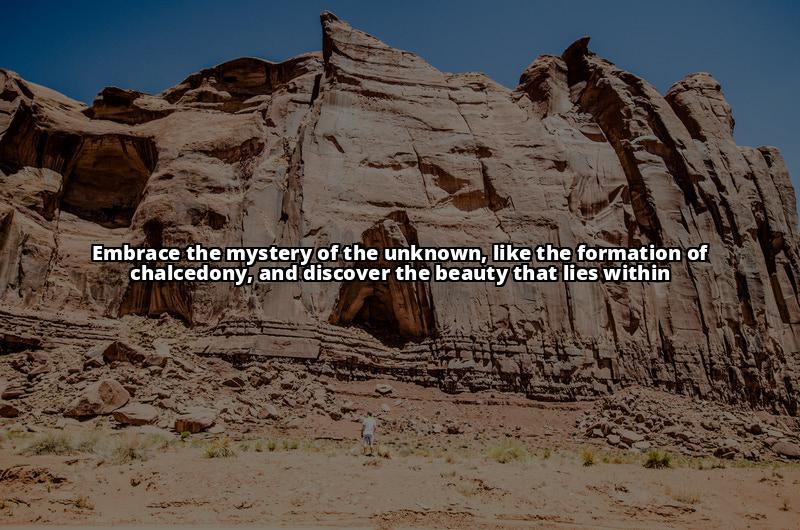Chalcedony is a fascinating gemstone that has captivated humans for centuries. Its unique properties and beautiful appearance make it a favorite among jewelry enthusiasts and collectors alike. In this article, we will delve into the origins, physical characteristics, uses, and evaluation of chalcedony, providing you with a comprehensive guide to this enchanting gemstone.
Discover the Enchanting World of Chalcedony: Origins, Uses, and More
What will the reader learn from this article?
- The geological origins and formation of chalcedony, including its formation in sedimentary, metamorphic, and volcanic environments.
- The physical characteristics of chalcedony, such as its hardness, specific gravity, and colors and patterns.
- The historical significance of chalcedony in jewelry making, contemporary uses, and popular varieties like agate, carnelian, and jasper.

Origins and Formation of Chalcedony
Chalcedony is a cryptocrystalline form of silica, composed of very fine intergrowths of quartz and moganite. These silica minerals play a crucial role in the formation of chalcedony, which occurs in a variety of geological environments. Let’s explore the origins and formation process of this gemstone.
Geological Origins
Chalcedony can be found in sedimentary, metamorphic, and volcanic environments. It is commonly associated with rocks such as limestone, basalt, and volcanic ash. The specific geological conditions necessary for chalcedony formation include temperature, pressure, and the presence of silica-rich solutions.
In sedimentary environments, chalcedony forms through the replacement of pre-existing minerals. As silica-rich fluids infiltrate the rock, they slowly replace the original minerals, forming chalcedony in their place. This process, known as diagenesis, can occur over millions of years, resulting in the formation of chalcedony veins or nodules within the host rock.
Metamorphic environments, on the other hand, involve the transformation of pre-existing minerals due to high temperature and pressure. During metamorphism, silica-rich fluids permeate the rock, causing the recrystallization of minerals into chalcedony. This process often occurs in regions where tectonic activity has led to the intense folding and deformation of rocks.
Volcanic environments offer another setting for the formation of chalcedony. When volcanic ash and lava cool, they can trap pockets of silica-rich fluids. Over time, these fluids solidify and form chalcedony, often encapsulating other minerals or organic matter. These unique specimens, known as geodes, can exhibit stunning patterns and colors.
Role of Silica Minerals
Quartz and moganite, both silica minerals, play a vital role in the formation of chalcedony. Quartz, a common mineral found in many rocks, serves as the primary component of chalcedony. Its microscopic crystals interlock with moganite, another form of silica, to create the dense and compact structure characteristic of chalcedony.
Moganite, a polymorph of quartz, is particularly important in distinguishing chalcedony from other forms of silica. While quartz and chalcedony share similar chemical compositions, the presence of moganite differentiates chalcedony. Moganite is more soluble than quartz, contributing to the unique solubility characteristics of chalcedony.
It is worth noting that chalcedony is not scientifically recognized as its own mineral species, but rather a form of quartz in microcrystalline form. However, the name “chalcedony” has historical significance and is widely used to describe this particular variety of quartz.
Chalcedony – Wikipedia provides a comprehensive overview of the geological origins and formation process of chalcedony, shedding light on the complex processes that give rise to this remarkable gemstone.

Physical Characteristics of Chalcedony
Chalcedony exhibits a range of physical characteristics that contribute to its allure and versatility. Let’s explore these features in more detail.
Hardness and Specific Gravity
Chalcedony has a hardness of 6.5 to 7 on the Mohs scale, making it relatively durable and suitable for everyday wear. Its specific gravity, a measure of density, ranges from 2.58 to 2.64, indicating its denser nature compared to other gemstones.
Colors and Patterns
Chalcedony occurs in various colors, ranging from translucent white and pale blue to vibrant hues of red, orange, yellow, and green. These colors are often caused by impurities or trace elements present during the gemstone’s formation.
One of the most well-known features of chalcedony is its unique patterns. Popular varieties such as agate, jasper, and onyx exhibit distinctive banding, dendritic patterns, and fortification lines. These patterns add depth and visual interest to chalcedony gemstones, making each piece truly one-of-a-kind.
Inclusions and Solubility
Chalcedony can contain inclusions, which are foreign materials trapped within the gemstone during its formation. These inclusions can range from mineral crystals to organic matter, adding to the gemstone’s allure. Some chalcedony specimens even resemble organic materials like wood or coral, further enhancing their beauty.
Furthermore, chalcedony is more soluble than quartz due to the presence of moganite. This solubility can result in the formation of unique features such as geodes and nodules. Geodes are hollow cavities lined with chalcedony crystals and often contain water or air bubbles. These specimens are highly prized by collectors for their aesthetic appeal.
To dive deeper into the physical characteristics of chalcedony, visit Chalcedony: The gemstone Chalcedony information and pictures, which provides detailed descriptions of various chalcedony gemstones, including agate, jasper, onyx, and more.

Chalcedony in Jewelry and Decorative Arts
Throughout history, chalcedony has been revered for its beauty and used extensively in jewelry and decorative arts. Let’s explore the historical significance of chalcedony and its contemporary uses in various art forms.
Historical Significance
Chalcedony has a rich history dating back to ancient civilizations. It was highly valued by the Egyptians, Greeks, and Romans, who used it in both personal adornment and religious rituals. Ancient Egyptians, in particular, believed that chalcedony possessed protective qualities and often used it in amulets and seals.
Contemporary Uses
In modern times, chalcedony continues to be a popular choice for jewelry designers. Its versatility and wide range of colors and patterns make it suitable for various jewelry pieces, including rings, necklaces, earrings, and bracelets. Chalcedony cabochons, with their smooth polished surfaces, are particularly favored for their elegant appearance.
Beyond jewelry, chalcedony also finds its place in decorative arts. The gemstone’s hardness and durability make it ideal for carving, engraving, and intaglio work. Skilled artisans create intricate designs and motifs on chalcedony surfaces, showcasing the gemstone’s natural beauty.
Cameos, which are carved gemstones with contrasting colors, often feature chalcedony as the base material. The gemstone’s layered structure allows for intricate designs to be etched into the surface, resulting in stunning artwork. Chalcedony also serves as a popular choice for gemstone cabochons, which are polished and domed gemstones used in various jewelry designs.
To explore the historical significance and contemporary uses of chalcedony in more depth, visit Chalcedony | Agate, Quartz & Jasper | Britannica, which provides insights into the use of chalcedony in gem engraving and decorative arts.

Popular Varieties of Chalcedony and their Distinctive Features
Chalcedony encompasses a wide range of varieties, each with its own distinctive features and characteristics. Let’s explore some of the most popular chalcedony varieties and their unique qualities.
Agate
Agate is one of the most well-known and widely used varieties of chalcedony. It is characterized by its banded appearance, which can feature a wide array of colors and patterns. Agate often exhibits concentric banding, resulting in mesmerizing circular patterns. This variety is highly valued for its beauty and is frequently used in jewelry and ornamental objects.
Carnelian
Carnelian is a vibrant orange to reddish-brown variety of chalcedony. Its warm tones and translucent nature make it a popular choice for gemstone jewelry. Carnelian has been highly regarded throughout history and was used in ancient Egypt to create intricate amulets and seals. Today, carnelian is often set in rings, pendants, and bracelets.
Chrysoprase
Chrysoprase is a green variety of chalcedony known for its apple-green color. It derives its vibrant hue from the presence of nickel impurities. Chrysoprase is esteemed for its refreshing color and is highly sought after by jewelry designers. This variety is often used as a centerpiece in rings, necklaces, and earrings, adding a touch of natural elegance to any ensemble.
Jasper
Jasper is a dense and opaque variety of chalcedony known for its earthy colors and unique patterns. It often features combinations of red, brown, yellow, and green, and can exhibit intricate banding or spotted patterns. Jasper has been used for centuries in jewelry and decorative arts, with ancient civilizations attributing protective and healing properties to this captivating stone.
This is just a glimpse of the diverse world of chalcedony varieties. For a more detailed description and images of popular chalcedony gemstones, including agate, carnelian, chrysoprase, and jasper, visit Chalcedony quartz: The mineral Chalcedony information and pictures.
| Physical Characteristic | Description |
|---|---|
| Hardness | 6.5 to 7 on the Mohs scale |
| Specific Gravity | 2.58 to 2.64 |
| Colors | Translucent white, pale blue, red, orange, yellow, green |
| Patterns | Banded, dendritic, fortification lines |
| Inclusions | Mineral crystals, organic matter |
| Solubility | More soluble than quartz, can form geodes and nodules |
Case Study: The Timeless Elegance of Chalcedony Jewelry
Introduction: Chalcedony has been adorning jewelry for centuries, captivating wearers with its beauty and versatility. Let’s explore the story of Sarah, a jewelry enthusiast who fell in love with chalcedony and its timeless elegance.
Sarah’s Discovery: Sarah’s fascination with gemstones led her on a quest to find the perfect piece of jewelry. As she entered a local jewelry store, her eyes were immediately drawn to a breathtaking chalcedony necklace on display. The delicate blue hues and translucent quality of the stone mesmerized her, and she knew she had found something special.
The Significance of Chalcedony: Sarah discovered that chalcedony has been cherished throughout history for its symbolic meanings. In ancient times, it was believed to promote calmness, harmonious relationships, and inner peace. Sarah resonated with these qualities, as she sought balance and tranquility in her own life.
Versatility in Design: Sarah was amazed by the versatility of chalcedony in jewelry design. The jeweler explained that chalcedony could be carved into intricate cameos or fashioned into smooth cabochon cuts. Sarah was particularly drawn to the ethereal beauty of chalcedony when set in a delicate silver pendant. Its translucent appearance seemed to capture the light, creating an enchanting glow around her neck.
Admiration and Compliments: Whenever Sarah wore her chalcedony necklace, she received numerous compliments. Friends and strangers alike were captivated by the stone’s unique color and undeniable allure. Sarah felt a sense of pride knowing that her jewelry choice had caught the attention of others and sparked conversations about the beauty of chalcedony.
Caring for Chalcedony: Sarah quickly learned that proper care and maintenance were essential to preserve the beauty of her chalcedony necklace. She followed the jeweler’s advice, using a soft cloth to gently clean the stone and avoiding exposure to harsh chemicals. Sarah found joy in the ritual of caring for her cherished piece, ensuring that it would continue to shine for years to come.
Conclusion: Sarah’s journey into the enchanting world of chalcedony had opened her eyes to the timeless elegance and significance of this gemstone. Through her personal experience, she had discovered the beauty, versatility, and historical significance of chalcedony in jewelry. Inspired by her own story, Sarah encouraged others to explore the world of chalcedony and appreciate its unique qualities in various forms of artwork and jewelry, just as she had.
Identifying and Evaluating Chalcedony
Identifying and evaluating chalcedony requires careful examination and knowledge of gemological techniques. Let’s explore the key factors to consider when identifying and assessing the quality of chalcedony gemstones.
Distinguishing Chalcedony
Distinguishing chalcedony from other gemstones and minerals can be challenging, especially when it comes to similar microcrystalline varieties. Gemological tools such as magnification, refract
FAQ
What is chalcedony?
Chalcedony is a type of microcrystalline quartz mineral.
Who can use chalcedony?
Chalcedony can be used by anyone interested in gemstones and crystals.
How is chalcedony formed?
Chalcedony forms through the deposition of silica-rich solutions in cavities.
What are the healing properties of chalcedony?
Chalcedony is believed to promote calmness, communication, and feelings of positivity.
How can I cleanse chalcedony?
Cleanse chalcedony by rinsing it with lukewarm water or using a soft brush.
What if I’m not satisfied with my chalcedony purchase?
We offer a money-back guarantee if you’re not satisfied with your chalcedony.






